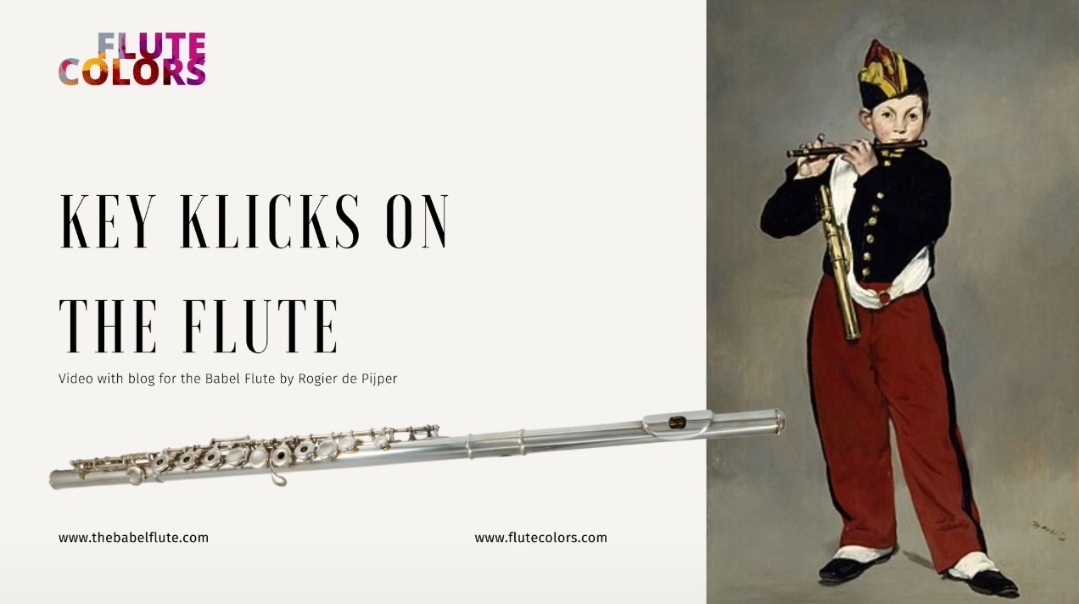
by Rogier de Pijper
When I was sixteen years old, my flute teacher gave me ‘Density 21.5’ by Varèse. In this piece, there is a technique that I had never played before. Above some notes, there is a plus sign indicated. The intention is to play a key click while playing the note. At that time, I found it to be a funny technique, but most of my attention was focused on the passage where the D7 has to be played frequently.

Key clicks and notation
There are two types of key clicks:
- Key clicks where you only click the key without blowing into the flute. These are often notated with a cross as the notehead.

- Key clicks where you click the key while blowing into the flute. These are often notated with a plus sign above or below the note.

Performance
Playing key clicks is not very difficult in itself. You lift your finger and hit the key a bit harder when closing it. In principle, you can use each individual finger of the fingering to play the key click, or you can choose to play the key click with all fingers of the fingering. Give it a try with this example:

In descending lines, it’s often easy to choose the finger. It’s usually the finger that comes next. If you want to play an ascending line, it becomes more challenging. Then you often have to lift the finger first and then put it back down. That can be tricky. Luckily, you can solve that by playing the key click with a different finger. Play the notes in the example below and use only the middle finger of the left hand to play the notes as key clicks.

Coordination
At first glance, the key click seems like a simple technique. It is indeed straightforward for playing a single note. However, it becomes more challenging when we start doing exercises for coordination with key clicks.
Key clicks are great for training coordination between fingers, and when combined with playing tones on the flute, they also train coordination between the fingers, tongue, and support. Let’s first look at an exercise from the Flute Colors book that focuses on training coordination between the fingers.
Below, we see two staves. The upper staff is for the left hand, and the lower staff is for the right hand. The cross in the fingering notated above the staff indicates which finger should be used to play the key click. For the left hand, it is the middle finger throughout the exercise, while for the right hand, a different finger should be used for each measure to play the key click.

You can also change this exercise: play quarter notes with the right hand (alternating fingers) and play eighth notes with the left hand (middle finger). There are more variations possible, such as sixteenth notes in one hand and quarter notes in the other hand, eighth note triplets against quarter notes, or quarter note triplets against quarter notes. Let your imagination run wild and make it as challenging as you can.
Clicking technique exercises

Key clicks can also be used to practice technique and difficult passages. In that case, play key clicks while blowing into the flute. Studying scales, for example, takes on a whole different dimension when you add key clicks.
Personally, I find it interesting to play the key clicks in such a situation using all the fingers of the fingering. If the coordination between the fingers, tongue, and support is not optimal, you will hear extra sounds. That is a sign that you haven’t fully mastered the scale yet and that there is still room for improvement. When the coordination is good, the key click and the technical passage you play are completely aligned without any extra sounds (extra notes).
One of my favorite exercises to incorporate key clicks is the first exercise from Reichert’s seven daily exercises.
1. Play the scale (in one key) once.
2. Play the same scale again, but this time with key clicks. Make sure you choose a tempo in which everything is perfectly aligned.
3. Play the scale once more without key clicks. Do you notice a difference between the first and last time?

Have fun!
Rogier de Pijper
www.flutecolors.com
Rogier de Pijper (1982) is a Dutch flutist and Altus artist. He is regularly active as a soloist, has acted as a substitute in various orchestras including Philharmonie Zuid Nederland and has given concerts and masterclasses in the Netherlands, Belgium, Germany, the Czech Republic, Italy, Finland and the United States of America. Various composers have written works for him, including Sandro Fazzolari (Italy) and Gregory Glancey (America).
In 2016 he published his book ‘Flute Colors’, 112 exercises to improve your flute playing with extended techniques. The book was sold in more than 20 countries around the world in just one year and translated into German within a month of its release. Rogier also wrote a beginner’s method for flute ‘Fluitmethode.nl’ and ‘Fluitmethode.be’.
Rogier has made various recordings and CDs. Some are played regularly on national radio in the Netherlands. He also played live on national radio the world premiere of ‘Chatouille!’ by Matthias Kadar.









Grazie, Rogier, per questo tuo contributo sulla tecnica flautistica.
Congratulazioni!